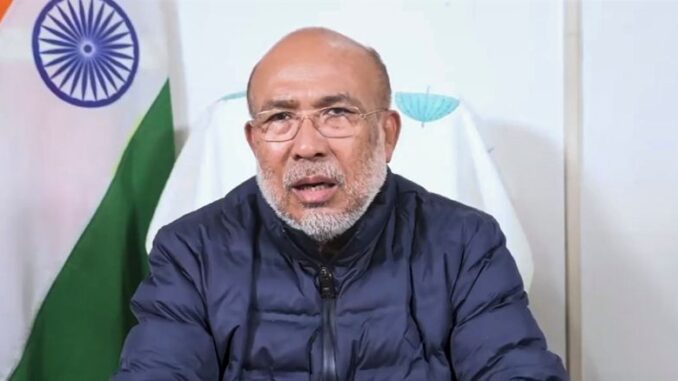
Manipur’s unending crisis continues to torment the state, with the recent violence shattering the uneasy calm between the people of the Imphal valley and a section of the hill communities in the uplands.

Manipur’s unending crisis continues to torment the state, with the recent violence shattering the uneasy calm between the people of the Imphal valley and a section of the hill communities in the uplands. For a brief period, public attention shifted to Shillong, capital of Meghalaya, where Chief Minister Conrad Sangma announced the withdrawal of his National Peoples Party’s (NPP) support to the state government.
The NPP, with seven MLAs, is the second largest group in the 60-member Assembly. The Assembly is dominated by the BJP, which holds a comfortable majority on its own with 37 MLAs and a coalition with smaller parties, including the JD(U) with six and the Naga Peoples Front with five. In a sharp denunciation of Chief Minister Biren Singh — the NPP remains in the NDA led by the BJP at the Centre — Sangma, who also heads the NPP, declared that “there was no confidence in our party in the current leadership of Biren Singh.” Though he pledged to work for peace, the party clarified that it would rejoin the government only if Singh was removed.
However, removing Singh is easier said than done. While it has been a demand of the Kuki groups, which have felt deeply aggrieved, the latest massacre of a Meitei family of six — three women and three children — triggered angry attacks on the homes of MLAs and ministers in the Imphal valley. The majority Meitei population lives in the valley. Among the main driving forces of the Meitei campaign is the COCOMI (Coordinating Committee on Manipur Integrity), an NGO representing the valley.
While the Centre has been silent on the demand for Singh’s removal, interviews with people on both sides of the divide indicate that the main challenge before the BJP and the Centre is to find a replacement who is strong enough to handle Manipur’s complex politics. This would include not just holding the balance with allies but also controlling civil society, dealing with insurgent groups, managing the media and keeping dissident MLAs in check. Until May 2023, when the ethnic eruption began, this cash-strapped state was seen as a place of promise and growth.
If anything, Singh has been a survivor. Over the years, he has honed his skills, besting rivals and rebels several times. In 2022, he led the BJP to a majority in the Assembly elections, crushing the Congress. A few weeks ago, much noise was made about a purported letter signed by 19 party MLAs critical of the CM, but it fizzled out.
In June last year, barely two months into the internecine conflict, Singh set out for Raj Bhavan with a resignation letter in hand for the Governor. A large crowd stopped the convoy, snatched the letter and tore it up in a theatrical, well-publicized display of support.
But Singh continues to face huge internal challenges. On November 21, 10 MLAs from the Kuki tribe, including seven from the BJP, attacked the state government, accusing it of favoring the majority Meiteis.
“The CM has mismanaged the situation from the start,” said Yumnam Joykumar Singh, national vice-president of the NPP and a former deputy chief minister in Biren Singh’s first term. “He says he is protecting the territorial integrity of Manipur, but where is this integrity? We cannot even travel to Jiribam or Moreh.”
Even as talk swirls around the imposition of President’s rule without the dissolution of the state legislature, the CM is unfazed. There is also growing criticism that he has no role in the security architecture, known as the Unified Command, which coordinates the security operations in the state.
The Centre’s point person for Manipur has been Home Minister Amit Shah and New Delhi’s response to the latest spasm of violence has been to restore the draconian Armed Forces Special Powers Act (AFSPA) in areas from where it had been lifted and to fly 5,000 additional paramilitary troopers to Manipur to bolster the already substantial presence of security forces. This muscular approach to security issues has evoked mixed reactions.
When the Home Minster announced an ambitious plan earlier this year to fence the 1,643-km Indo-Myanmar border, Nagaland and Mizoram stiffly opposed it, while Tripura, Manipur and Arunachal Pradesh, all BJP-governed states, welcomed it. Singh’s government and BJP MLAs have opposed AFSPA’s reimposition. Some say that this concern stems from the fact that the sweeping law can be used against militias and vigilante groups, some of which are said to be close to the state’s leadership.
Editor Pradip Phanjoubam said in an interview that the primary challenge was the proliferation of weapons accompanied by acute lawlessness, with a growth of pro-government militias as well as armed rebels of virtually all ethnic groups. “Anybody who has a gun in his hand becomes the law,” he remarked. He described the bouts of fragile calm as an “absence of violence” in a “frozen conflict”. An undercurrent of grievances and unmet aspirations runs across the state, threatening to erupt at the slightest provocation.
The identity of the protagonist or antagonist often depends upon the perception of the viewer. In one incident, 10 Kuki men who were killed when fired upon by a CRPF unit, have been described variously as insurgents or village guards, depending on who is speaking. The precise circumstances which provoked the shooting remain unclear, as do many situations in Manipur.
A person with knowledge of the situation said that the Kukis had automatic weapons and had been trained by rebel cadres who sometimes led them there and elsewhere.
Revenge is also a factor. In the latest burst of violence in Jiribam, the ill-fated family, members of a relief camp, were walking to a market when an armed group took them captive. The group was reportedly seeking to avenge the death of a young Hmar woman allegedly killed by a Meitei vigilante group. The Hmars, while listed as a Scheduled Tribe, are part of the larger Kuki-Chin-Mizo group of tribes.
There are economic issues, too. Jiribam is a major entry point from Assam. It has a mixed population of Bengali-speaking Muslims, Meiteis and Hmars while a railhead, the earliest in Manipur, and a major highway have made it a commercial center. Different political groups as well as competing non-state armed groups have long vied for control here. It is in such complex frameworks that the ongoing conflict needs to be understood.
The impact of Manipur’s tragedy appears limited to the Northeast. It has not become a live election or political issue across India. While warranting a few sentences in political campaigns across the country and rousing talks by opposition lawmakers in Parliament when issues conflagrate, it draws the occasional scathing editorial, commentary and news report in the media. Top officials and political leaders in Delhi remain occasionally engaged and deeply concerned, but the lack of a long-term strategy is visible.
(Sanjoy Hazarika combines roles as researcher, columnist, mentor and practitioner. Author, journalist, filmmaker, policy analyst and human rights advocate, he is a former reporter for the New York Times)





Be the first to comment